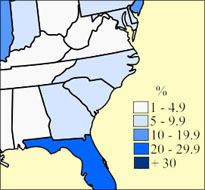Mandated by the U.S. Constitution and administered every 10 years, the U.S. Census is used to determine apportionment of federal funds to local communities, as well as the distribution of state seats in the House of Representatives. The data provided in the government’s report, released again March 2011, provides ample opportunities for journalists to identify and explore local trends.
A 2011 report from the Harvard Kennedy School of Government’s Rappaport Institute for Greater Boston and Taubman Center for State and Local Government, “Which Places Are Growing? Seven Notable Trends from 2010 Census Data,” examines trends within the income and population data.
The report’s findings include:
- Counties with higher income as of 2000 experienced higher population growth.
- Counties with higher average January temperatures experienced higher population growth than those with lower temperatures.
- Population growth was greater in counties close to a coastal or inland port than in those located farther from ports.
- The least dense quartile of counties experienced population loss while the most dense quarter of counties experienced population growth.
- More highly educated counties (as measured by the proportion of the adult population with a college degree) experienced higher population growth.
- Counties with a large share of employment in manufacturing experienced less population growth.
- Limits to housing supply limit the amount of population growth experienced by a county.
Tags: economy


Expert Commentary